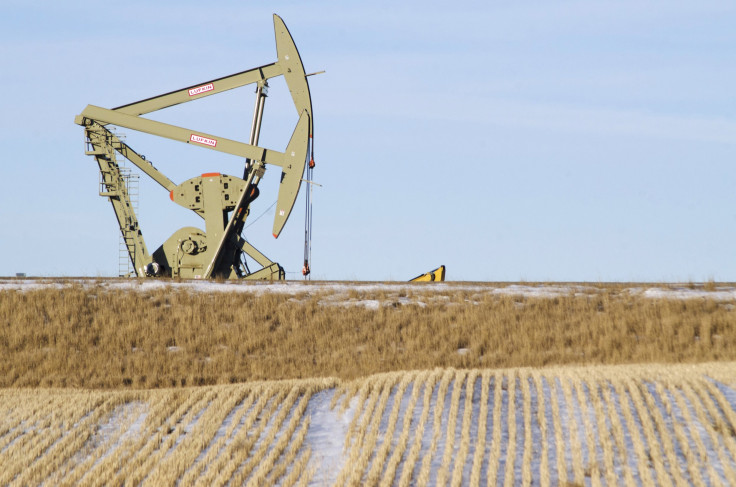Crude Oil Price Declines Mean Steady Loss Of Oil, Gas Jobs

Like tens of thousands of other out-of-towners, Ryan Chennault moved to western North Dakota for the oil. Since 2008, he’s worked as a maintenance roustabout, fixing and looking after wells in the booming shale fields of the Bakken formation.
“You’re always nervous about the next paycheck,” says Chennault, 32, who lives in Minot. “At the same time, when it’s good out here, it’s really good.”
Now is not one of those times. As global crude prices settle near five-year lows, American oil and gas companies are adjusting by slowing production and cutting labor costs. Between October and February, employment in the oil and gas extraction subsector fell by 3,200 workers, according to the U.S. Bureau of Labor Statistics. And since last December, these firms have announced 91,000 energy-related job cuts, according to Continental Resources Inc., an oil and gas producer based in Oklahoma City, Oklahoma, that is at the forefront of modern-day shale drilling.
Among the states hit hardest by the price plunge is North Dakota, where a lack of easy market access, a dearth of pipelines and geological idiosyncrasies combine to make the cost of doing business higher than in traditional oil-producing states such as Texas. Nationwide, the industry is grappling with low prices, but they’re particularly challenging in the Bakken.
Since his boss began feeling the pinch, Chennault hasn’t been called to work in two weeks. He’s frustrated the company’s office personnel still get to work regular hours -- they’re cheaper to keep around than roustabouts -- even though it’s people in the field like him who produce the wealth, he says.
But Chennault, who supports a wife and two young children on his income, is confident he’ll get back to work soon. He budgets for layovers like this since he's weathered similar stretches before. Low global crude prices kept him idle for three months in 2009, and for two months in 2012. “I know it’s coming,” he says. “It happens every two years.”
In those cases, oil prices rebounded after the shocks. Many wonder if it's different this time around.
“People are basically holding their breath,” says Peter R. Hartley, an economics professor at Rice University who specializes in energy. “It depends on how long the shock’s going to last.”
Oil prices depend on multiple factors and are notoriously hard to predict. Booming domestic production, an appreciating dollar and weak demand in Europe and Asia have all played roles in shaping today’s low prices. After a steep fall, prices have stabilized in a band around $50 a barrel, although it is unclear how long they will remain there. If current prices hold, U.S. drillers will ease production more substantially during the next few months. In turn, that means more layoffs and wage cuts than those already announced.
William Spriggs, chief economist at the AFL-CIO labor federation, says he expects the sector to shed another 40,000 jobs before hitting an employment level similar to 2008, before the oil boom kicked off. “I’d love to keep those jobs,” he says, but notes the losses are already being offset in other, slowly growing sectors such as construction and manufacturing.
While the oil and gas business generates enormous profits -- and hefty political sway -- it does not employ that many workers relative to other industries. Amid a historic boom, oil and gas producers have added close to 80,000 jobs since 2005. By comparison, the steadily recovering construction industry has added roughly 1 million jobs since 2011.
“In the aggregate, I think the U.S. economy is strong enough that growth in other sectors will continue to keep overall job growth positive,” says Luke Tilley, vice president and chief economist at Wilmington Trust.
That means the brunt of job loss is mostly limited to industry hubs such as western North Dakota. In the boomtown of Williston, average rents are unlikely to stay higher than those in Los Angeles and New York for much longer. Nor is the city’s Walmart outlet likely to maintain starting pay at $17 an hour. In February, North Dakota even surrendered to Nebraska its spot as the state with the lowest unemployment rate.
“It’s a reminder we need to continue to diversify our economy,” says State Sen. Mac Schneider, who also works as a labor lawyer. “Is western North Dakota going to empty out or are the people who came here going to stay? That has yet to be decided.”
Meanwhile, roustabout Chennault is optimistic he’ll be back to work soon. He doesn’t own his house in North Dakota, but says he’s there for the long haul with his family.
“Oh yeah, I’m not going anywhere,” he says. “There’s twenty years’ worth of oil in the ground.”
© Copyright IBTimes 2024. All rights reserved.





















